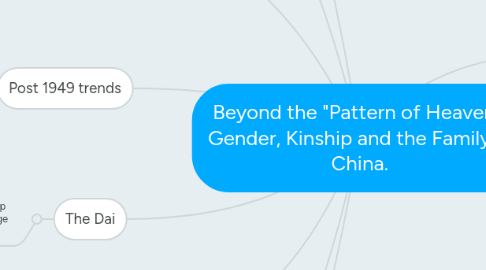
1. Confucianism
1.1. Founded by Kong Fuzi in the 6th century
1.1.1. Confucianism is an open system, and people (namely men) may join through self cultivation, not by birth.
1.1.1.1. Confucianism's emphasis on filal piety is not limited to the relationship between sons and fathers, but requires that children of both sexes honor their father and mother equally.
1.1.1.1.1. Men according to Confucianism should strive to be 'junzi' (gentlemen), acting with ren (compassion) and observing li (propriety,ritual). Women are encouraged to be a good wife and mother, and to help the men in life become 'Junzi.'
2. The Mosuo
2.1. A matrilineal group residing in Southwest China
2.1.1. Both men and women reside in natal households
2.1.1.1. Society functions without husbands or fathers
3. The Lahu
3.1. A Tibeto-Burman speaking group residing in the mountains of Burma.
3.1.1. Show no preference of male or female child
3.1.1.1. Husband and wife expected to share workload
4. The Dai
4.1. The Dai are a group of 300,000 the Dai kinship is bilateral. Dai lack surnames that make lineage membership easily identifiable.
4.1.1. Divorce: A divorce could occur at either request of man or woman
5. Post 1949 trends
5.1. Despite the new revolutionary and institutional milieu created by the Communist party, policies are generally regarded as having strengthen the traditional Chinese family.
5.1.1. Kinship and Lineages were replaced by Communist Party Organizations.
5.1.1.1. In 1982. the government began a vigorous campaign against the feudal ideas that caused families to prefer boys over girls and urged the media to publicize cases of female infanticide.
6. Nuanced Approach to Han Chinese Gender and Kinship
6.1. The uterine family consisted of mothers and their children, who belonged to her husband's patriline.
6.1.1. By focusing her energy and efforts on her uterine family, a woman may create a future source of influence and security not found in her husbands family.
6.1.1.1. The Chinese family from the female perspective is the same as patrilineal unit, rather a domestic unit that centers on herself.
6.1.1.1.1. Uterine families should not be necessarily be seen as being more egalitarian toward women, however, since they continued to depend heavily on the woman's son.
7. The Surname
7.1. The importance of the Han Chinese patriline is reflected in Chinese kinship terms the formerly strict rules of surname exogamy.
7.1.1. Kinship terms for the fathers side of the family are numbers and varied. and there are distinctive terms (often differing in terms of relative age) for related males from the great-great grandfather to the more distantly related third cousin.
7.1.1.1. All holders of a given surname were believed to have descended from a common ancestor.
7.1.1.1.1. Since decent was traced though the male line, marriage to a woman born into the group descended from the great-great grandfather was deemed appropriate.
8. Life Stages of Han Woman
8.1. Tradition placed the female in an extremely inferior position.
8.1.1. Due to their subordinate position, women should defer to men throughout their lives: first to their fathers, then to their husbands, upon widowhood to their sons.
8.1.1.1. Poor families may be particularly reluctant to "waste" precious resource on a member who would not be able to perform as much labor on behalf of the group and marry out.
8.1.1.1.1. The most important life even for the Han woman is marriage.
9. Background
9.1. Traditional Chinese culture, with its heavy Confucian influence. is often portrayed as an example of extreme patrilineality with women playing a nearly invisible role in the family line.
9.1.1. Greater access to mainland China in the last 25 years is showing just how complex Chinese culture is.
9.1.1.1. The majority ethnic group is China is the Han at nearly 92% of the population, with the remaining 8% divided among 55 different minority groups.
9.1.1.1.1. Monica Cable. explores the interrelationship between gender, kinship and the family in what scholars have frequently termed Chinese culture.
10. The Han Chinese
10.1. Under China's first emperor Qin Shihuang ethinc were united and all groups shared the written language.
10.1.1. Han Chinese identity was formed during the Han Dynasty (206 BC-220 AD). Several factors unite this otherwise heterogeneous group. Two of the most important ones being the Confucian tradition and patrilineal.
